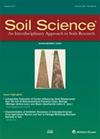利用铁水处理残渣作为土壤改良剂,改善土壤物理功能和抗洪能力
4区 农林科学
Q2 Agricultural and Biological Sciences
引用次数: 2
摘要
摘要土壤退化是一项全球性挑战,与气候变化和粮食安全有着内在联系。土壤退化的原因有很多,但所有退化的土壤都与土壤结构不良有关。联合国可持续发展目标12、13和15致力于负责任的消费和生产,建设零废物循环经济,到2030年实现净零废物,并扭转土地退化,以保护我们最宝贵的资产之一——土壤。制止甚至扭转土壤退化的全球努力需要有机和无机材料的来源来重建土壤结构。水处理残留物(WTR)是一种来自清洁水处理的有机矿物废物,全球产量不断增加,这意味着这种废物的可持续再利用提供了一个潜在的及时机会。回收或再利用WTR到土地上在世界各地是司空见惯的,但受到基于材料化学性质的限制。很少有研究关注铁- wtr应用的物理影响及其重建土壤结构的潜力,特别是提高其保持水分和抵抗洪水影响的能力。本文介绍了一项新的研究,其中使用Fe-WTR和Fe-WTR/堆肥[1:1]共改性已被证明有利于土壤的保水性、渗透性、体积变化和强度特性。WTR的施用量为干质量的10%和30%。与对照土相比,共改性土的导水率提高了5.7倍(570%),抗剪强度提高了54%,饱和含水量提高了25%。单次WTR改性后,饱和导水率提高26倍,抗剪强度提高129%,饱和含水量提高13.7%。数据表明,WTR作为单一改良剂可以显著改善土壤的物理特性,其中抗剪强度和导水率是应用中最重要的因素。虽然Fe-WTR与堆肥的共施在抗剪强度和水力导电性方面的改善程度低于单一WTR,但共施具有最佳的保水性能,并提供补充的有机含量,这对土壤健康(即维持生态系统功能和支持植物的能力)至关重要的环境应用是有益的。我们开发了“蓄洪能力”一词来全面描述土壤提供的物理生态系统服务,它不仅包括重量水含量,还包括由于有机丰富土壤中体积增加而产生的额外储水潜力,土壤的透过性(水力导电性)和土壤的剪切强度,这决定了土壤抵抗水运动侵蚀力的能力。本文章由计算机程序翻译,如有差异,请以英文原文为准。
Reusing Fe water treatment residual as a soil amendment to improve physical function and flood resilience
Abstract. Soil degradation is a global challenge that is intrinsically linked to climate change and food security. Soil degradation has many causes, but all degraded soils suffer from poor soil structure. The UN’s Sustainable Development Goals 12, 13 and 15 strive towards responsible consumption and production, building a zero-waste circular economy, achieving net zero by 2030 and reversing land degradation to protect one of our most valuable assets, soil. Global efforts to stop and even reverse soil degradation require sources of both organic and inorganic materials to rebuild soil structure. The increasing global production of water treatment residual (WTR), an organo-mineral waste product from clean water treatment, means that the sustainable reuse of this waste provides a potential timely opportunity. Recycling or reuse of WTR to land is commonplace across the world but is subject to limitations based on the chemical properties of the material. Very little work has focused on the physical impacts of Fe-WTR application and its potential to rebuild soil structure particularly improving its ability to hold water and resist the effects of flooding. This paper presents novel research in which the use of Fe-WTR and Fe-WTR/compost [1:1] co-amendment has shown to be beneficial for a soil’s water retention, permeability, volume change, and strength properties. Application rates of WTR were 10 and 30 % by dry mass. Compared to the control soil, co-amended samples have 5.7 times the hydraulic conductivity (570 % improvement), 54 % higher shear strength and 25 % greater saturated water content. Single WTR amendment had 26 times the saturated hydraulic conductivity (2600 % improvement), 129 % higher shear strength and 13.7 % greater saturated water content. Data indicates that WTR can be added as a single amendment to significantly improve soil physical characteristics where shear strength and hydraulic conductivity are the most important factors in application. Although the co-application of Fe-WTR with compost provides a lesser improvement in shear strength and hydraulic conductivity compared to single WTR amendment, the co-amendment has the best water retention properties and provides supplementary organic content, which is beneficial for environmental applications where the soil health (i.e. ability to sustain ecosystem functions and support plants) is critical. We develop the term ‘flood holding capacity’ to holistically describe the physical ecosystem services that soil delivers, which incorporates not only the gravimetric water content but the extra water storage potential due to increases in volume that occur in organic rich soils, the transmissivity of the soil (hydraulic conductivity) and the shear strength of a soil, which determines how well a soil will resist the erosive forces of water movement.
求助全文
通过发布文献求助,成功后即可免费获取论文全文。
去求助
来源期刊

Soil Science
农林科学-土壤科学
CiteScore
2.70
自引率
0.00%
发文量
0
审稿时长
4.4 months
期刊介绍:
Cessation.Soil Science satisfies the professional needs of all scientists and laboratory personnel involved in soil and plant research by publishing primary research reports and critical reviews of basic and applied soil science, especially as it relates to soil and plant studies and general environmental soil science.
Each month, Soil Science presents authoritative research articles from an impressive array of discipline: soil chemistry and biochemistry, physics, fertility and nutrition, soil genesis and morphology, soil microbiology and mineralogy. Of immediate relevance to soil scientists-both industrial and academic-this unique publication also has long-range value for agronomists and environmental scientists.
 求助内容:
求助内容: 应助结果提醒方式:
应助结果提醒方式:


